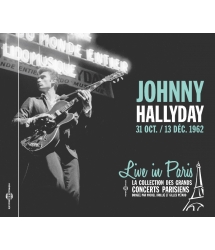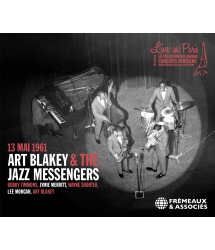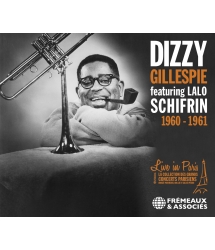- Our Catalog
- Philosophy
- Philosophers of the 20th century and today
- History of Philosophy (PUF)
- Counter-History and Brief Encyclopedia by Michel Onfray
- The philosophical work explained by Luc Ferry
- Ancient thought
- Thinkers of yesterday as seen by the philosophers of today
- Historical philosophical texts interpreted by great actors
- History
- Books (in French)
- Social science
- Historical words
- Audiobooks & Literature
- Our Catalog
- Jazz
- Blues
- Rock - Country - Cajun
- French song
- World music
- Africa
- France
- Québec / Canada
- Hawaï
- West Indies
- Caribbean
- Cuba & Afro-cubain
- Mexico
- South America
- Tango
- Brazil
- Tzigane / Gypsy
- Fado / Portugal
- Flamenco / Spain
- Yiddish / Israel
- China
- Tibet / Nepal
- Asia
- Indian Ocean / Madagascar
- Japan
- Indonesia
- Oceania
- India
- Bangladesh
- USSR / Communist songs
- World music / Miscellaneous
- Classical music
- Composers - Movie Soundtracks
- Sounds of nature
- Our Catalog
- Youth
- Philosophy
- News
- How to order ?
- Receive the catalog
- Manifesto
- Dictionnary











- Our Catalog
- Philosophy
- Philosophers of the 20th century and today
- History of Philosophy (PUF)
- Counter-History and Brief Encyclopedia by Michel Onfray
- The philosophical work explained by Luc Ferry
- Ancient thought
- Thinkers of yesterday as seen by the philosophers of today
- Historical philosophical texts interpreted by great actors
- History
- Books (in French)
- Social science
- Historical words
- Audiobooks & Literature
- Our Catalog
- Jazz
- Blues
- Rock - Country - Cajun
- French song
- World music
- Africa
- France
- Québec / Canada
- Hawaï
- West Indies
- Caribbean
- Cuba & Afro-cubain
- Mexico
- South America
- Tango
- Brazil
- Tzigane / Gypsy
- Fado / Portugal
- Flamenco / Spain
- Yiddish / Israel
- China
- Tibet / Nepal
- Asia
- Indian Ocean / Madagascar
- Japan
- Indonesia
- Oceania
- India
- Bangladesh
- USSR / Communist songs
- World music / Miscellaneous
- Classical music
- Composers - Movie Soundtracks
- Sounds of nature
- Our Catalog
- Youth
- Philosophy
- News
- How to order ?
- Receive the catalog
- Manifesto
- Dictionnary
1952-1958
SIDNEY BECHET
Ref.: FA5889
Artistic Direction : Gilles Pétard et Michel Brillié
Label : FREMEAUX & ASSOCIES
Total duration of the pack : 3 hours 46 minutes
Nbre. CD : 3
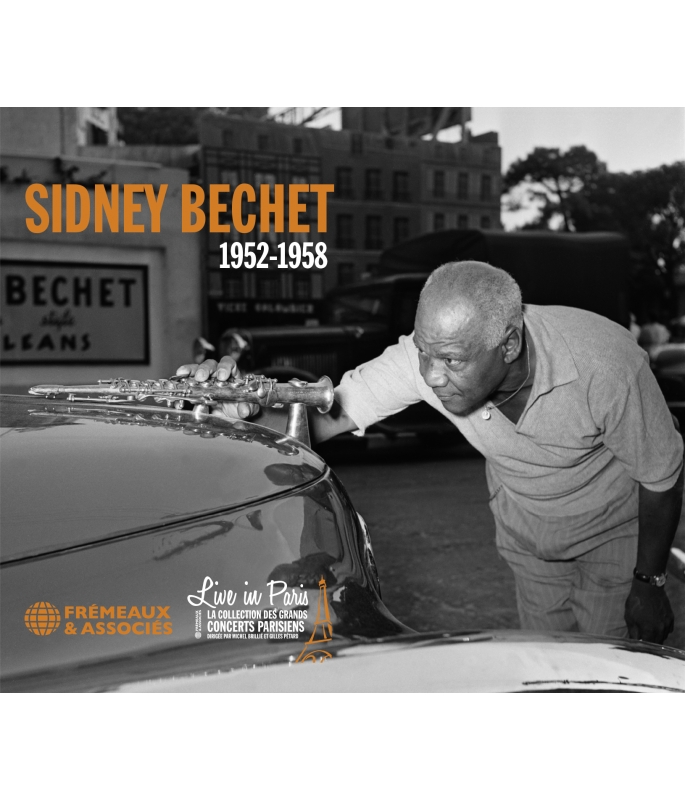
1952-1958
- - Choc Classica
Sidney Bechet, like Louis Armstrong, was among the greatest musicians of his time and one of the first great jazz soloists. This 3 CD set brings together live recordings of concerts given mainly in Paris between 1952 and 1958, and they capture the very essence of the extraordinary swing this jazz veteran displayed in the fifties. Like a true rock star before his time, Bechet set crowds on fire with his virtuoso skills, his charisma and his contagious fervour. Here we have precious evidence of the tremendous excitement that his concerts aroused, and his music has the same effect today, thanks to his incandescent playing that causes vibrations in every listener.
Patrick FRÉMEAUX
The Live in Paris collection by Michel Brillié allows listeners to hear previously-unreleased recordings (made at concerts and private or radio-sessions) by the great 20th stars in jazz, rock & roll and song. These “live” takes, and the artists’ rapport with their audiences, gives these performances an additional soul and sensibility in counterpoint to the rigorous demands of studio recordings. Particular care was taken when restoring the sound of these tapes in order to meet CD standards while preserving the original colours of the period.
Patrick FRÉMEAUX & Gilles PÉTARD
CD1 : AMERICAN RHYTHM • MUSKRAT RAMBLE • I’VE FOUND A NEW BABY • I GOT RHYTHM • SAINT-LOUIS BLUES • CASEY JONES • PETITE FLEUR • DIPPERMOUTH BLUES • FRANKIE AND JOHNNY • ROYAL GARDEN BLUES • ROYAL GARDEN BLUES (BIS) • AS-TU LE CAFARD ? • STRUTTIN’ WITH SOME BARBECUE • SEPTEMBER SONG • LES OIGNONS.
CD2 : SOCIETY BLUES • SUMMERTIME • MARCHAND DE POISSONS • SWEET GEORGIA BROWN • DANS LES RUES D’ANTIBES • AMERICAN RHYTHM • BUDDY BOLDEN STOMP • MONTMARTRE BOOGIE WOOGIE • AS-TU LE CAFARD ? • RIVERBOAT SHUFFLE • HALLE HALLELUJAH • WHEN THE SAINTS GO MARCHIN’ IN • TEMPERAMENTAL MOOD • SOBBIN’ AND CRYIN’.
CD3 : MUSKRAT RAMBLE • ON THE SUNNY SIDE OF THE STREET • SAINT LOUIS BLUES • I’VE FOUND A NEW BABY • PETITE FLEUR • MOI J’EN AI MARRE • DOWN BY THE OLD MILL STREAM • COQUIN DE BOUBOU • ROYAL GARDEN BLUES • PETITE FLEUR • LES OIGNONS • BACK HOME AGAIN IN INDIANA • SAINT LOUIS BLUES • ALL OF ME • WHEN THE SAINTS GO MARCHIN’ IN.
DIRECTION ARTISTIQUE : GILLES PÉTARD ET MICHEL BRILLIÉ
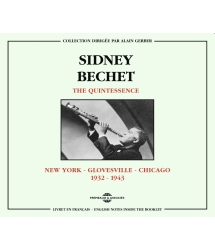
NEW-YORK - GLOVESVILLE - CHICAGO 1932 - 1943
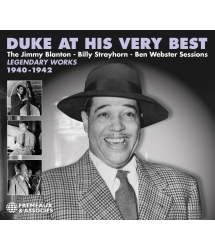
Legendary Works 1940-1942
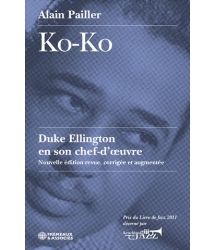
Nouvelle édition revue, corrigée et augmentée
...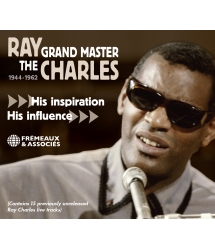
His Inspiration / His Influence 1944-1962




-
PisteTitleMain artistAutorDurationRegistered in
-
1American RhythmSidney BechetSidney Bechet00:01:311952
-
2Muskrat RambleSidney BechetKid Ory00:05:331952
-
3I’ve Found a New BabySidney BechetWilliams00:08:031952
-
4I Got RhythmSidney BechetGeorge Gershwin00:07:201952
-
5Saint-Louis BluesSidney BechetWilliam Christopher Handy00:06:471952
-
6Casey JonesSidney BechetTraditionnel00:03:411952
-
7Petite fleurSidney BechetSidney Bechet00:03:191952
-
8DippermouthSidney BechetKing Oliver00:03:561952
-
9Frankie and JohnnySidney BechetTraditionnel00:05:321952
-
10Royal Garden BluesSidney BechetSpencer Williams00:05:341952
-
11Royal Garden Blues (Bis)Sidney BechetSpencer Williams00:04:151952
-
12As-tu le cafard ?Sidney BechetSidney Bechet00:05:261952
-
13Struttin’ With Some BarbecueSidney BechetLouis Armstrong00:08:021952
-
14September SongSidney BechetAnderson Weill00:03:001952
-
15Les OignonsSidney BechetSidney Bechet00:04:071952
-
PisteTitleMain artistAutorDurationRegistered in
-
1Society BluesSidney BechetSidney Bechet00:09:051952
-
2SummertimeSidney BechetDubose Heyward00:03:381952
-
3Marchand de poissonsSidney BechetSidney Bechet00:03:061952
-
4Sweet Georgia BrownSidney BechetKenneth Casey00:09:161952
-
5Dans Les rues d’AntibesSidney BechetSidney Bechet00:05:221952
-
6American RhythmSidney BechetSidney Bechet00:00:351954
-
7Buddy Bolden StompSidney BechetSidney Bechet00:03:421954
-
8Montmartre Boogie WoogieSidney BechetSidney Bechet00:05:351954
-
9As-tu le cafard ?Sidney BechetSidney Bechet00:06:111954
-
10Riverboat ShuffleSidney BechetHoagy Carmichael00:05:081954
-
11Halle HallelujahSidney BechetSidney Bechet00:07:031954
-
12When The Saints Go Marchin’ InSidney BechetSidney Bechet00:08:101954
-
13Temperamental MoodSidney BechetSidney Bechet00:03:101954
-
14Sobbin’ and Cryin’Sidney BechetSidney Bechet00:05:071954
-
PisteTitleMain artistAutorDurationRegistered in
-
1Muskrat RambleSidney BechetKid Ory00:04:051954
-
2On The Sunny Side Of The StreetSidney BechetDorothy Fields00:03:381954
-
3Saint Louis BluesSidney BechetWilliam Christopher Handy00:07:271954
-
4I’ve Found A New BabySidney BechetJack Palmer00:06:341954
-
5Petite FleurSidney BechetSidney Bechet00:03:271954
-
6Moi j’en ai marreSidney BechetMaurice Yvain00:03:241957
-
7Down By the Old Mill StreamSidney BechetTell Taylor00:03:041957
-
8Coquin de boubouSidney BechetSidney Bechet00:02:441958
-
9Royal Garden BluesSidney BechetSpencer Williams00:07:031958
-
10Petite fleurSidney BechetSidney Bechet00:03:321958
-
11Les oignonsSidney BechetSidney Bechet00:04:041958
-
12Back Home Again in IndianaSidney BechetBallard Mc Donald00:06:081958
-
13Saint Louis BluesSidney BechetWilliam Christopher Handy00:07:241958
-
14All of meSidney BechetGerald Marks00:03:171958
-
15When the Saints Go Marchin’ inSidney BechetSidney Bechet00:09:001958
Sidney Bechet 1952-1958
Sidney Bechet, Saxing it up
By Michel Brillié
A Juan-style wedding
Juan-les-Pins, August 17, 1951. The little town on the French Riviera is jubilant. Just think, this old Creole grandpa, the king of popular jazz is getting married! Sidney Bechet weds Elizabeth Ziegler, a German lady he has known for ages – since 1928. The beautiful people are here; French star Mistinguett is one witness; neighbor Picasso drops by. The whole gang of Bechet musician friends is all here too. And so is the local daily paper Nice Matin:
The procession starts from the National Square, where horses, trucks, lavish limos, carriages, colorful Citroën sedans await the occupants…/… A whistle blows, and the procession sets off towards the town hall. At its head are half a dozen cowboys led by a charming horsewoman.
Then comes the large float on which the famous Juanese orchestra Tomas and his Merry Boys sound off their brass, drums and even the firmly-moored piano…/… Finally appears the bride and groom’s carriage, a pram lent by H.S.H. the Prince of Monaco. Claude Luter and all of Sydney Bechet’s fellow instrumentalists unleash saxes and trumpets on the crowd and in honor of the bride and groom.[19]
The Sax-slinger
Indeed, France is familiar ground for the “Emperor of Soprano”. He has been coming and going there since the early twenties, particularly in the fall of 1925, during his collaboration with the famous Revue Nègre, along with Joséphine Baker. As everyone knows, the young dancer is a hit at the Théâtre des Champs-Elysées. She does a stunning charleston number with the choreographer Louis Douglas. Nearby, a jazz ensemble performs against a fragmented background of ocean liners, skyscrapers and construction equipment. It is conducted by pianist Claude Hopkins, with a dozen American jazzmen, including Sidney Bechet on clarinet. An instrument he will soon exchange for a “carrot”, the soprano saxophone in French jazz slang: it has more breadth, more breath, more sound.
That’s the classier part of Bechet’s French adventures. Three years later, things get tougher. Bechet, who is already in a relationship with Elizabeth Ziegler – he has set her up in an apartment on Rue du Rocher in Paris – Sidney plays all over the city, at the Ambassadeurs, at the Plantation, at Florence’s… And after his gigs, the musician usually goes to have a drink and jam, at Bricktop’s, or at the Grand Duc. It is in this last bar that he starts arguing with another musician on how to play a piece. His opponent is Mike McKendrick, a Chicago banjo player. A slightly nervous guy, too.
He calls on Sidney: ‘I don’t think I like you,’ he said. ‘I don’t think I like the way you look, Dixie-boy. You want to see what we do to people like you in Chicago?’ He pulled out a gun and fired two shots at me. I pulled out my own gun then—he hadn’t hit me—and my first bullet grazed his forehead. Then Glover heard the shots and he came running out, and one of my bullets got him in the leg, and another hit a girl, and one ricochetted off a lamp-post and, what’s really unfortunate, hit some Frenchwoman who was passing on the other side of the street on her way to work.”[20]
This shooting rodeo happened two days before Christmas 1928, with a quick result: both men were arrested. At his trial a month later, Bechet was sentenced to fifteen months in prison in Fresnes. He was also banned from staying in France, despite the intervention in his favor by Louis Aragon.
A Caddy in the hold
Bechet would only return there twenty years later. But with style. Two French citizens urged him to return: Nicole Barclay on the one hand, and Charles Delaunay, of the Hot Club de France, who came to meet him in New York with a specific project: a jazz festival in Paris, early May 1949. Barclay and Delaunay ended up partnering for the event. The opening took place on May 8. Here they were, next to the 52-year-old veteran (Bechet was born May 14, 1897): Miles Davis, Charlie Parker, Max Roach… Hot Lips Page, Don Byas, Toots Thielemans. Plus the two French backing bands for Bechet: Pierre Braslavsky’s ensemble, and Claude Luter’s Lorientais. Listening to the sound archive of May 15, 1949 from the Public French Radio vaults[21], the final jam-session of the concert of the day was totally delirious. The “tamed catastrophe”, jazz’s definition by French poet Jean Cocteau, triggered a real revolution. And this all genres combined: the “trads” on one side, Bechet, Hot Lips Page, the “mods” on the other, Parker, Davis. The latter was backstage listening to Bechet’s set. Someone asked him if he, being the leader of the new cool jazz sound, was fond of the New Orleans style. Davis’s reply was typically forthright: “I don’t know if this is the music of New Orleans, or Texas, or wherever, but it sure is music and this old guy can really play it. He’s fantastic.”[22]
The soprano intrumentalist was hailed as the “greatest triumphant of the festival” by critic/musician André Hodeir: “such youth despite his white hair!”[23]
Following a short New-York interlude, Here’s Sidney Bechet again disembarking in Le Havre, along with a magnificent Cadillac in the hold, that he personally drives all the way to Paris. The car will then be a permanent fixture of his transatlantic crossings. The artist is now adored by French youth, and performs concerts and recordings throughout this second part of the year. Bechet has a good idea: he takes up the theme of an old Creole classic, Les Echalotes , (the shallots) already revisited by his friend Albert Nicholas two years before. To make it simpler, Bechet renames it... … Les Oignons (Onions).[24]
King Creole
Fast forward to June 1950. For the umpteenth time, Bechet sets foot on French soil. He will never leave it. Some have often elaborated on the reasons that attached him to France; true, his Creole roots must have come into play. There is his ancestor in the 18th century, Françoise Cocotte… Bechet, for his part, gives a more down-to-earth explanation: “And at the same time I was asking myself: ‘Why am I here?’
Well, just as soon as I asked the question I knew why. France, it’s closer to Africa. I’ve wanted to be as close to it as I could. It’s a mood, you’d call it, an atmosphere I wanted to put myself into. My grandfather, he was Africa. It was like getting back, and I wanted to get back as far as I could.
It’s all true, all that I said about my grandfather. And it’s all so mixed up with the music. In Paris it’s like I can hear all what was happening to it when my grandfather was making it, back in those days when it had just been brought over from Africa and was still finding itself in the South.”[25]
In his reference work on the saxophonist,[26] Christian Béthune offers an even deeper reason:
“France evokes, in a much more significant way for Sidney Bechet, the imagery of a repressed Creole aristocracy, a lost paradise he almost knew. By striving to always speak in French, by insisting that one spells his name “Béchet” …/… he finally makes manifest a Creole lineage that circumstances had until then led him to decline.”
Bechomania
For Bechet, the fifties marked his reunion with noble roots; with an emotional balance – marriage to the long-awaited bride; and with, finally, popular success. It was impossible to be a child or a teenager at that time and miss out these typically French tunes: Les Oignons, Petite Fleur, Dans les Rues d’Antibes, Marchand de Poissons. If Frank Ténot finds that “these jukebox hits are a little far from the authenticity of the music of his beginnings, however, a great lyrical breath animates all his warm and pulpy solos,.. His wide vibrato went straight to the heart of the audience.”[27]
France has become “bechomaniac” according to the neologism invented by Hugues Panassié. And the man who “came alive into the legend”, as Boris Vian writes, now had his own palace in Saint-Germain-des-Prés: the “Vieux Co”, the kind moniker that jazz musicians gave to the “Vieux Colombier” club. The soprano player established his base there in 1949, right after his triumph at the Paris Festival. He regularly performed there up until 1953. And in summer, nothing changed: the Côte d’Azur version of the “Vieux Colombier”, in Juan les Pins, welcomed him from July 1950.
The French press, always slow to start, finally acknowledged the ongoing phenomenon. In his jazz chronicles of the time for the monthly Jazz Hot, Boris Vian does not miss a beat. He mischievously pointed out the blunders of journalists, little yet aware of this new frenzy:
“A good friend from Algiers sent me a clipping worth its pretty penny, from the Daily Dispatch of Algiers: …/…“Magnificently dominating the situation, Sidney, placid under a harsh light, glowed with sweat and excitement and his trumpet howled heartbreaking laments…”
The grand prize of the month goes to another clipping from the New Republic of Bordeaux and the South West: “The admirers of Sidney Bechet listen to their idol playing with the hardships of a trumpeter…”
Vian concluded: To confuse a trumpet and a soprano, you have to put some good will into it, even if you are not interested in jazz. ”[28]
Vandals at the Olympia
When Bechet would play in Paris, his favorite venue was undoubtedly the Olympia Theater on the Boulevard des Capucines, close to the Madeleine Church. Director Bruno Coquatrix bought the house early 1954, and later on December 8 Bechet performed there for the first time in a long series. The fever rose gradually and reached its peak three months later, during the March 8, 1955 concert arranged by Jazz Hot Magazine for its twentieth birthday.
“The centre stage was mobbed by a bunch of 17-year-old kids…/…They didn’t care for the artists or the rest of the audience, and these hysterical youngsters stood on the chairs, started raising hell, and danced the bebop in the aisles…”[29] Jean-Michel Boris, Coquatrix’s right arm, was all shook up. Well, he hadn’t seen nothing yet… Bechet came back next June at the Olympia, this time as a star. Young up-and-coming chanteur Charles Aznavour was opening the show.
Bu all hell broke loose in the fall. On October 19, 1955, to celebrate the 200,000 sold copies of Les Oignons, Vogue Records booked the music hall for a free concert by Sidney Bechet. Fans swarmed the place and carried out a proper sacking… “Chairs flew across the room like velvet automats” wrote Boris. The French Home Department remained factual: “Two Million Francs and thirty-two cents of damage, plus seven wounded, including two members of the feline staff of the renowned theater.”
Quite an incredible uproar for an easy-going , almost sixty-yeay-old musician , with a rather minimalist showmanship… But there it is, the music was tremendous, and there was a need to let off steam. That drive was first introduced there by Gilbert Bécaud, earlier on in February. The post-war teen generation had let loose, and Bécaud had brought down the house.
Name that tuna
Luckily, Bechet had found a peaceful haven to get away from the city din or his boisterous fans… This man who had traveled around the world, who had lived in the red light districts of New-Orleans or New-York, the gunslinger of Montmartre, was to end his days like a retired bowler in Grigny, a far away village 25 km outside Paris. “A spot of green well-liked by the Parisians” says the local town hall paper. With less than 3.000 inhabitants in 1950, this little hamlet in the Seine et Oise district would welcome him and allow the jazzman to live his final years, finally married, famous, and at last a father.
Looking at a satellite view of the modest suburban house at 10, rue Pierre Brossolette, one can hardly imagine today the jazzy atmosphere of the fifties, with musician friends and personalities of that era driving up in sumptuous American convertibles… Under the weeping willow in his garden, Bechet hosted picnics – probably the first barbecue parties on the French soil.
At the local café, Sidney played the role of sugar daddy, offering rounds of candy to the kids. With this kind of show, people loved him. In the nearby streams, Sidney fished. “I fish for tuna,” he said seriously, a slight mistake about the local fauna, easily explainable for a musician…
Then he would drive off in his customized Samson sedan: Sidney had replaced the radiator cap by a silver clarinet. In the passenger seat sat Yank, his dog. It was a cushy life, indeed, but it was life, no?…
A solar genius
This went on for ten years. Bechet died of cancer at his home on 14 May 1959. A few days later, several thousand admirers flocked to the church in Garches to pay a last tribute to the king of the soprano. This also marked the end of the “good-natured”, post-war period. The world to come changed its tune: six months after Bechet’s death, a new music style was presented on French radio. A 30-minute weekly program made its debut: it was called Salut les Copains. (Hi Friends) The teens of Saint- Germain-des-Prés gave way to baby-boomers. The decade of popular jazz music was over; it was time for the era of rock ‘n’ roll.
In fact, Bechet may be this unique link in the history of music in France, unique because this “solar star”[30] is extraordinary. “Bechet was for me the epitome of jazz… Everything he played in his life was completely original” wrote Duke Ellington on his gravestone at Garches Cemetery. He knew what he was talking about: in the twenties, the Duke recruited Bechet in his orchestra, impressed by his coloful and powerful sound. When he let him go – Bechet was too out of control - Ellington would have to hire two experienced musicians to fulfill his role: Johnny Hodges on alto sax and Barney Bigard on clarinet.[31]
Bechet was unique especially by his versatility. “New Orleans was his favorite style. But his universality allowed him to play without being disoriented with musicians as different as Bunk Johnson, Charlie Shavers, Charlie Parker, Dizzy Gillespie, Woody Herman or Martial Solal. He also composed music for ballet and movies, not to mention his hits.”[32] Neither “new”, nor modern: just jazz, period.
Hence the admiration and respect for Bechet of other giants: Johnny Hodges, whom Bechet coached in his early days, and to whom he gave a soprano; John Coltrane, who of course studied Bechet’s sound on his favourite instrument;[33] or Roland Kirk, who reprised Petite Fleur, his final tip of the hat to the “beautiful master of the soprano saxophone”.[34]
Coda for Bechet
Well almost. More than 60 years later, there are still heirs who keep Sidney Bechet’s music alive. First there is Bechet’s son, Daniel. As a drummer, (he was a student of Kenny Clarke) he regularly pays tribute to his father’s repertoire during his concerts. Olivier Franc is yet another successor: his father played with Pierre Braslavsky’s group, that accompanied Bechet at the festival of ‘49. Franc plays in Europe as well as in New Orleans as one of the best representatives of the master’s music. Incidentally, he plays on one of the sopranos that belonged to Bechet.
And then, over there, on the other side, there’s Allen Stewart Konigsberg. For decades, every Monday, he has played the clarinet in a traditional jazz ensemble in Manhattan. The man is Woody Allen, and he has always said that his passion for the clarinet came from Sidney Bechet in the fifties: “A friend of mine had bought a tape recorder. He had recorded a radio program with a Sidney Bechet live concert. When I listened to the tape, I was fascinated. I had never heard anyone play like that. I immediately went to buy a soprano saxophone and started to teach myself how to play it. Then I switched to the clarinet.”[35]
The filmmaker also used extensively Bechet’s repertoire in his 2011 film, Midnight in Paris... After his marriage to Soon Yi Previn in 1997, he adopted a one-year-old girl the following year. And he named her: Bechet Allen.
Michel Brillié
© Frémeaux & Associés 2024
CD1
1 American Rhythm (Sidney Bechet) 01’31
2 Muskrat Ramble (Kid Ory) 05’33
3 I’ve Found a New Baby (Williams) 08’03
4 I Got Rhythm (Gershwin) 07’20
5 Saint-Louis Blues (W.C. Handy) 06’47
6 Casey Jones (Traditional) 03’41
7 Petite fleur (Sidney Bechet) 03’19
8 Dippermouth Blues (King Oliver) 03:56
9 Frankie and Johnny (Traditional) 05’32
10 Royal Garden Blues (Spencer Williams / Clarence Williams) 05’34
11 Royal Garden Blues (Bis) (Spencer Williams / Clarence Williams) 04’15
12 As-tu le cafard ? (Sidney Bechet) 05’26
13 Struttin’ With Some Barbecue (Louis Armstrong) 08’02
14 September Song (Anderson Weill) 03’00
15 Les Oignons (Sidney Bechet) 04’07
Recording Date
March 12,1952
Recording Place
Salle Pleyel, Paris, France
Produced by:
Disques Vogue
Personnel
Christian Azzi piano
Sidney Bechet soprano sax
Roland Bianchini bass
François «Moustache» Galépidès drums
Guy Longnon trumpet
Claude Luter clarinet
Claude Rabiani trumpet
Bernard Zacharias trombone
CD2
1 Society Blues (Sidney Bechet) 09’05
2 Summertime (D. Heyward / G. Gershwin) 03’38
3 Marchand de poissons (Sidney Bechet) 03’06
4 Sweet Georgia Brown (Kenneth Casey / Ben Bernie - Maceo Pinkard) 09’16
5 Dans Les rues d’Antibes (Sidney Bechet) 05’22
6 American Rhythm (Sidney Bechet) 0’35
7 Buddy Bolden Stomp (Sidney Bechet) 03’42
8 Montmartre Boogie Woogie (Sidney Bechet) 05’35
9 As-tu le cafard ? (Sidney Bechet) 06’11
10 Riverboat Shuffle (Hoagy Carmichael/Irving Mills/Dick Voynow) 05’08
11 Halle Hallelujah (Sidney Bechet) 07’03
12 When The Saints Go Marchin’ In (Trad arrgt. Sidney Bechet) 08’10
13 Temperamental Mood (Sidney Bechet) 03’10
14 Sobbin’ and Cryin’ (Sidney Bechet) 05’07
Recording Dates
March 12,1952 tracks 1 to 5 • December 8,1954 tracks 6 to 14
Recording Places
Salle Pleyel, Paris, France tracks 1 to 5 • Olympia Theater, Paris, France tracks 6 to 14
Produced by:
Disques Vogue
Personnel
tracks 1 to 5 : same as CD1
tracks 6 to 14:
Sidney Bechet soprano sax
Roland Bianchini bass
Marcel Blanche drums
Pierre Dervaux trumpet
Claude Luter clarinet
Claude Philippe banjo
Yannick Singery piano
Gil Thibaut trumpet
Benny Vasseur trombone
CD3
1 Muskrat Ramble (Kid Ory) 04’05
2 On The Sunny Side Of The Street (Dorothy Fields / Jimmy McHugh) 03’38
3 Saint Louis Blues (W.C. Handy) 07’27
4 I’ve Found A New Baby (Jack Palmer / Spencer Williams) 06’34
5 Petite Fleur (Sidney Bechet) 03’27
6 Moi j’en ai marre (M. Yvain / G. Arnauld Albert Willemetz) 03’24
7 Down By the Old Mill Stream (Tell Taylor) 03’04
8 Coquin de boubou (Sidney Bechet) 02’44
9 Royal Garden Blues (Spencer Williams / Clarence Williams) 07’03
10 Petite fleur (Sidney Bechet) 03’32
11 Les oignons (Sidney Bechet) 04’04
12 Back Home Again in Indiana (Ballard McDonald / James Hanley) 06’08
13 Saint Louis Blues (W.C. Handy) 07’24
14 All of me (Gerald Marks / Seymour Simons) 03’17
15 When the Saints Go Marchin’ in (Trad arrgt. Sidney Bechet) 09’00
Recording Dates
December 8,1954 tracks 1 to 5
May 27, 1957 tracks 6 & 7
July 17, 1957 track 8
June 29, 1958 tracks 9 to 11
July 29, 1958 and August 3, 1958 tracks 12 to 15
Recording Places
Olympia Theater, Paris, France tracks 1 to 8
Cyrano Theater, Versailles, France tracks 9 to 11
Exposition Universelle, Bruxels, Belgium tracks 12 to 15
Produced by:
Disques Vogue tracks 1 to 5
Lucien Morisse, Bruno Coquatrix, Frank Ténot & Daniel Filipacchi tracks 6 to 11
Disques Vogue tracks 12 to 15
Personnel
- tracks 1 to 5: same as CD2
- tracks 6 & 7
Sidney Bechet soprano sax
Marcel Blanche drums
Georges “Zozo” d’Halluin bass
Jean-Louis Durand trombone
Guy Longnon trumpet
André Reweliotty clarinet
Yannick Singery piano
- tracks 9 to 11
same as above, except:
Roland Hug trumpet
Arnaud Poumi drums
- tracks 12 to 15
Sidney Bechet soprano sax
Buck Clayton trumpet
Vic Dickenson trombone
Kansas Fields drums
Arvell Shaw bass
George Wien piano
Dedicated to Claude Boquet, Bill Dubois, Jean Claude, Philippe Moch,
Raymond Treillet and the gang
[1] Francis Brugna, Nice Matin, 17 aout 1951
[2] Sidney Bechet, Treat it Gentle, Da Capo Press, 2022, p 150
[3] Youtube: All Star jam session- May 15, 1949 Salle Pleyel, Paris [Charlie Parker, Miles Davis, a.o.]
[4] John Chilton, Sidney Bechet, the Wizard of Jazz, London, McMillan Press, 1987, p 216
[5] André Hodeir, in Jazz Hot, juin 1949
[6] Raymond Oliver, le premier chef français à avoir sa propre émission culinaire à la télévision (Arts et Magie de la Cuisine), en avait naturellement fait son générique dès fin 1954.
[7] Sidney Bechet, Treat it Gentle, Da Capo Press, 2022, p 45
[8] Christian Béthune, Sidney Bechet, Editions Parenthèses, 1997, p 129
[9] Frank Ténot, Dictionnaire du jazz, Robert Laffont, 1988
[10] Boris Vian, Chroniques de Jazz, Editions 10/18, 1975 p 458
[11] Jean Michel Boris, Jean François Brieu, Éric Didi, Olympia Bruno Coquatrix, Editions Hors Collection, 2003, p21
[12] Les J3 sont en 1955 l’équivalent des teenagers des sixties, ou des ados d’aujourd’hui. J3 était la catégorie de cartes d’alimentation les concernant…
[13] Christian Béthune, Sidney Bechet, Editions Parenthèses, 1997, p 161
[14] Con Chapman, Rabbit’s Blues, Oxford University Press, 2019, p 29
[15] Philippe Hervouët, in Sidney Bechet, le roi de la carotte, par Philippe Corbou, Ouest France, 22 octobre 2019
[16] Coltrane lui dédie « Blues for Bechet », morceau sur son album Coltrane Plays the Blues, Atlantic Records, 1962
[17] Christian Béthune, Sidney Bechet, Editions Parenthèses, 1997, p 130
[18] Serge Loupien, Le cinéaste aux quatre oscars souffle à l’Olympia, Libération, 4 mars 1996
[19] Francis Brugna, Nice Matin, August 17 ,1951
[20] Sidney Bechet, Treat it Gentle, Da Capo Press, 2022, p 150
[21] Youtube: All Star jam session- May 15, 1949 Salle Pleyel, Paris [Charlie Parker, Miles Davis, a.o.]
[22] John Chilton, Sidney Bechet, the Wizard of Jazz, London, McMillan Press, 1987, p 216
[23] André Hodeir, in Jazz Hot, juin 1949
[24] Raymond Oliver, the first French chef to have his own culinary show on television in 1954 (Arts et Magie de la Cuisine), had used it as the theme song for the program.
[25] Sidney Bechet, Treat it Gentle, Da Capo Press, 2022, p 45
[26] Christian Béthune, Sidney Bechet, Editions Parenthèses, 1997, p 129
[27] Frank Ténot, Dictionnaire du jazz, Robert Laffont, 1988
[28] Boris Vian, Chroniques de Jazz, Editions 10/18, 1975 p 458
[29] Jean-Michel Boris, Jean-François Brieu, Eric Didi, Olympia Bruno Coquatrix, Editions Hors Collection, 2003, p21
[30] Christian Béthune, Sidney Bechet, Editions Parenthèses, 1997, p 161
[31] Con Chapman, Rabbit’s Blues, Oxford University Press, 2019, p 29
[32] Philippe Hervouët, in Sidney Bechet, le roi de la carotte, par Philippe Corbou, Ouest France, 22 Octobre 2019
[33] Coltrane dedicates “Blues for Bechet” to him, a number on his album Coltrane Plays the Blues, Atlantic Records, 1962
[34] Christian Béthune, Sidney Bechet, Editions Parenthèses, 1997 , p 130
[35] Serge Loupien, The filmmaker with four Oscas blows at the Olympia, Libération, March 4, 1996

